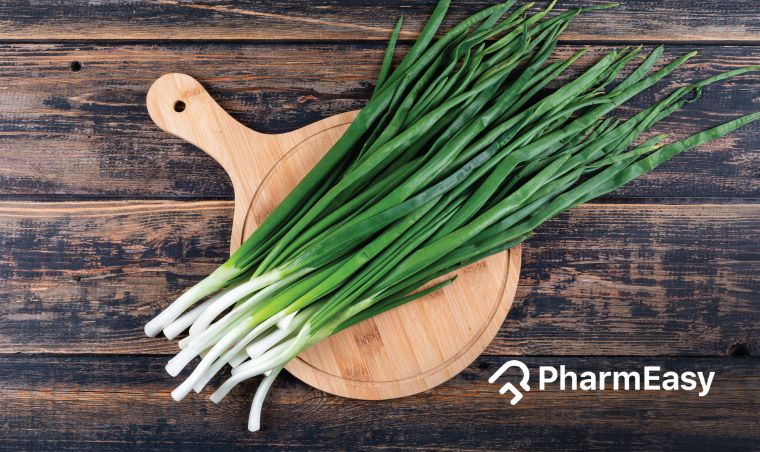When it comes to adding that extra burst of flavor and vibrant color to your dishes, alliums like scallions and chives are always at the top of the list.
But wait, aren’t they the same thing?
Well, brace yourself for a mouthwatering showdown between chives and scallions as we unravel the delicious differences that will elevate your culinary creations to new heights.
Get ready to dive into the world of these sprightly greens and discover the distinctive qualities that set them apart.
Let’s dig in!
chives vs scallions
Chives and scallions are both members of the allium family but they have distinct differences.
Scallions, harvested early, have a small white base and long green stalks that can be used in cooking.
Both the white and green parts of scallions can be consumed raw or lightly cooked.
On the other hand, chives are slender, hollow green leaves that are typically used as a herb or garnish.
They have a milder flavor compared to scallions.
While scallions are often mistaken for spring onions due to their appearance, spring onions have a larger, more bulbous white base.
Key Points:
- Chives and scallions belong to the allium family but have distinct differences.
- Scallions have a small white base and long green stalks that can be used in cooking.
- Both the white and green parts of scallions can be consumed raw or lightly cooked.
- Chives are slender, hollow green leaves used as a herb or garnish, with a milder flavor than scallions.
- Scallions are often confused with spring onions, but spring onions have a larger, more bulbous white base.
- Chives and scallions are used differently in cooking, with scallions being more versatile and chives used primarily as a garnish.
chives vs scallions – Watch Video


Pro Tips:
1. Chives are a member of the onion family, while scallions are actually young onions that have not yet developed a bulb.
2. Unlike chives, which are typically grown for their leaves, scallions are valued for both their green tops and the small bulbs at the bottom.
3. Chives have a milder flavor compared to scallions, making them a popular addition to dishes where a subtle onion taste is desired.
4. Chives have a long history of medicinal use, being utilized for their antibacterial and antifungal properties.
5. Both chives and scallions are low in calories and packed with vitamins and minerals, but chives boast a higher concentration of nutrients like vitamin K and vitamin C compared to scallions.
1. Scallions: A Member Of The Allium Family
Scallions, also known as green onions or spring onions, are part of the allium family, which includes other popular members like garlic, onions, and chives. They are known for their mild onion flavor and are widely used in various cuisines around the world.
2. Early Harvest: The Characteristic of Scallions
One of the distinguishing characteristics of scallions is that they are harvested early in their growth stage, typically before they fully mature. This early harvesting gives scallions their slender shape and tender texture, making them ideal for both raw and cooked dishes.
- Scallions are harvested early in their growth stage.
- They have a slender shape and tender texture.
- Suitable for both raw and cooked dishes.
3. Small White Base: Identifying Scallions
Scallions are identifiable by their small white base, a bulb-like structure that grows underground. Unlike regular onions, scallions have a smaller and less prominent white base. The white part gradually transitions into long green stalks, which are the most commonly used part of the scallion in cooking.
4. Long Green Stalks: The Signature Look of Scallions
Scallions are renowned for their long, slender, and vibrant green stalks. These stalks are highly desired for their distinct flavor and crunchy texture. The green part of scallions can be versatilely incorporated into culinary creations to provide a refreshing, onion-like taste.
- The long, slender, and vibrant green stalks of scallions are particularly sought-after.
- Scallions add a distinct flavor and crunchy texture to dishes.
- The green part of scallions can be used in various culinary applications.
- Scallions contribute a fresh and onion-like taste to dishes.
5. Cooking with Scallions: Utilizing Both White and Green Parts
One of the unique aspects of scallions is that both the white and green parts can be used in cooking. The white base of scallions offers a slightly milder flavor compared to the green stalks. The white part is often used as a garnish or in dishes where a milder onion flavor is desired. The green stalks, on the other hand, are ideal for adding a punch of flavor to stir-fries, soups, salads, and many other dishes.
6. Raw or Lightly Cooked: Ways to Enjoy Scallions
Scallions, also known as green onions, can be enjoyed in various ways. Whether eaten raw or lightly cooked, they offer a mild onion flavor and a crisp texture.
Here are some popular ways to incorporate scallions into your meals:
- Salads: Add chopped scallions to your favorite salad to enhance its freshness and add a hint of oniony flavor.
- Salsas: Dice scallions and mix them with tomatoes, cilantro, lime juice, and other ingredients to create a delicious salsa.
- Sandwiches: Include sliced scallions in your sandwiches for a refreshing crunch and added taste.
- Baked potatoes: Use scallions as a tasty topping on baked potatoes, along with sour cream, cheese, or other preferred garnishes.
- Seafood dishes: Scallions make a great accompaniment to seafood, whether grilled, baked, or sautéed.
- Stir-fries: Lightly cooked scallions can contribute a subtle onion flavor to stir-fry dishes, adding depth and complexity.
- Omelets: Chop scallions and incorporate them into your omelet filling for an extra kick of flavor.
- Stir-fried noodles: Sprinkle chopped scallions over stir-fried noodles to elevate the taste and provide a pleasing visual contrast.
In summary, scallions are versatile and can enhance the flavor and texture of various dishes. Try incorporating them into your meals for a fresh and flavorful experience.
Here are some key takeaways:
- Scallions offer a mild onion flavor and crisp texture.
- They can be enjoyed raw or lightly cooked.
- Popular uses include salads, salsas, sandwiches, baked potatoes, seafood dishes, stir-fries, omelets, and stir-fried noodles.
7. Scallions Vs. Spring Onions: Not the Same Thing
Scallions and spring onions may be used interchangeably in cooking, but it’s crucial to distinguish between the two.
- Scallions are harvested before they fully mature, resulting in a milder flavor and tender texture.
- On the other hand, spring onions are allowed to grow to a more advanced stage, resulting in a slightly stronger taste and firmer texture.
Next time you’re at the grocery store, keep these differences in mind when choosing the perfect onion for your recipe.
8. Spring Onions: Recognizing the Differences
Spring onions, also known as green onions in some regions, have a similar appearance to scallions but with a few distinguishing features. One of the key differences is their larger white base. Unlike scallions, spring onions have a more pronounced and bulbous white base. This difference in size and shape is an indication of their maturity level.
9. Larger White Base: The Distinctive Feature of Spring Onions
The larger white base of spring onions gives them a stronger and more pungent onion flavor compared to scallions. This makes spring onions a popular choice in dishes where a more intense onion flavor is desired. The green stalks of spring onions are also used in cooking, although they may have a slightly tougher texture compared to scallions.
10. Bulbous White Base: Another Trait of Spring Onions
Spring onions are distinguishable from scallions by their larger size and bulbous white base. This bulb-like structure adds to their unique appearance and enhances their flavor when cooked.
Scallions, on the other hand, have a smaller and less rounded white base. They are harvested early and have long green stalks. Scallions can be consumed either raw or lightly cooked.
Both spring onions and scallions belong to the allium family but possess distinct culinary characteristics. Spring onions, with their larger and more bulbous white base, offer a stronger onion flavor. Understanding these differences can help elevate your culinary skills and enable you to create even more mouthwatering dishes.

You may need to know these questions about chives vs scallions
Can I substitute chives for scallions?
Yes, you can easily substitute chives for scallions. Chives have a distinct herbaceous and onion-like taste, making them a great alternative, especially when used in dishes that require raw scallions. Their similar flavor profile ensures that the substitution will not drastically alter the taste of the recipe. Whether sprinkled over a salad or used as a garnish, chives can successfully provide the desired onion-y flavor when scallions are not available.
What’s the difference between scallions and green onions and chives?
Even though they may appear similar, scallions, green onions, and chives have distinct differences. Scallions and green onions, classified as vegetables, belong to the same plant species and have heartier and thicker stalks compared to delicate chives. On the other hand, chives are considered herbs, alongside parsley and basil, offering a milder flavor profile. Whether you prefer the robustness of scallions and green onions or the delicate taste of chives, these three ingredients bring unique characteristics to the culinary world.
Do chives taste like scallions?
Chives and scallions may appear similar in appearance, but their flavors differ greatly. While scallions have a robust, onion-like taste, chives offer a more subtle and herbaceous flavor. This contrast in flavors is what distinguishes chives as an herb and scallions as a vegetable. So, if you’re seeking a milder and herbaceous flavor, opt for chives, whereas if you prefer a stronger onion flavor, scallions would be a better choice.
How much chives equals 2 scallions?
The ratio of chives to scallions can vary depending on personal preference, but a general estimate would be that 2 scallions approximately equal 4 to 6 tablespoons of finely chopped chives. However, if scallions are used as a garnish in the recipe, chives make an excellent substitute and can be used without the need for precise measurement. Their similar flavor profiles allow for seamless integration, enhancing the dish with a refreshing hint of onion.
Reference source
https://www.foodnetwork.com/how-to/packages/food-network-essentials/chives-vs-green-onions
https://www.thepioneerwoman.com/food-cooking/cooking-tips-tutorials/g36122413/scallion-substitute/
https://www.escoffieronline.com/the-difference-between-chives-scallions-and-green-onions/
https://silva-intl.com/blog/chives-scallions-and-green-onions-whats-the-difference



